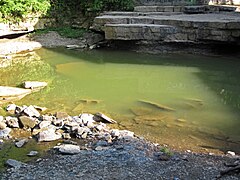| Glenshaw Formation | |
|---|---|
| Stratigraphic range: Pennsylvanian | |
 Outcrops of Brush Creek Limestone, Glenshaw Formation, in Ohio | |
| Type | sedimentary |
| Unit of | Conemaugh Group |
| Sub-units | Ames Limestone Member, Mahoning Sandstone Member, Brush Creek Limestone |
| Underlies | Casselman Formation |
| Overlies | Allegheny Formation |
| Lithology | |
| Primary | shale, siltstone, sandstone, red beds, coal |
| Other | limestone |
| Location | |
| Region | Appalachian Plateau |
| Country | United States |
| Extent | Pennsylvania, Maryland, West Virginia, Ohio |
| Type section | |
| Named by | N. K. Flint, 1965 [1] |
The Glenshaw Formation is a mapped sedimentary bedrock unit in Pennsylvania, Maryland, West Virginia, and Ohio, of Pennsylvanian age. It is the lower of two formations in the Conemaugh Group, the upper being the Casselman Formation. The boundary between these two units is the top of the marine Ames Limestone. [2] The Conemaugh Group overlies the Upper Freeport coal bed of the Allegheny Formation and underlies the Pittsburgh coal seam of the Monongahela Group.
The Conemaugh Group consists of cyclic sequences of shale, siltstone, sandstone, red beds, thin impure limestone, and thin nonpersistent coal. Red beds are associated with landslides. [3]
The thickness of the Conemaugh Group averages about 400 feet in Ohio, and it ranges from 450 feet on the Ohio River in West Virginia to 520 feet in Washington County, Pennsylvania, and then to 890 feet in Somerset County, Pennsylvania. [4]
The Glenshaw formation was originally mapped in Pennsylvania by Flint, [1] but was extended into West Virginia by Cardwell et al. in 1968. [5] It is also recognized in eastern Ohio. [6]
Footnotes
- ^ a b Flint, N.K., 1965, Geology and mineral resources of southern Somerset County, Pennsylvania: Pennsylvania Geological Survey County Report, 4th series, no. 56A, 267 p.
- ^ Assessment of Appalachian Basin Oil and Gas Resources: Carboniferous Coal-bed Gas Total Petroleum System http://pubs.usgs.gov/of/2004/1272/2004-1272.pdf
- ^ Casselman Formation https://mrdata.usgs.gov/geology/state/sgmc-unit.php?unit=PAPAcc;6
- ^ Assessment of Appalachian Basin Oil and Gas Resources: Carboniferous Coal-bed Gas Total Petroleum System http://pubs.usgs.gov/of/2004/1272/2004-1272.pdf Citing Arkle and others, 1979; Collins; 1979; Edmunds and others, 1999
- ^ Cardwell, D.H., Erwin, R.B., and Woodward, H.P., 1968, Geologic Map of West Virginia: West Virginia Geological and Economic Survey, 2 sheets, scale 1:250,000
- ^ Rice, C.L., Hiett, J.K., and Koozmin, E.D., 1994, Glossary of Pennsylvanian stratigraphic names, central Appalachian basin, IN Rice, C.L., ed., Elements of Pennsylvanian stratigraphy, central Appalachian basin: Geological Society of America Special Paper, 294, p. 115-155.
- Carboniferous Kentucky
- Geologic formations of Pennsylvania
- Geologic formations of Maryland
- Carboniferous West Virginia
- Carboniferous Ohio
- Pennsylvanian Series
- Carboniferous geology of Virginia
- Carboniferous southern paleotropical deposits
- Southern United States geologic formation stubs
- Maryland geography stubs